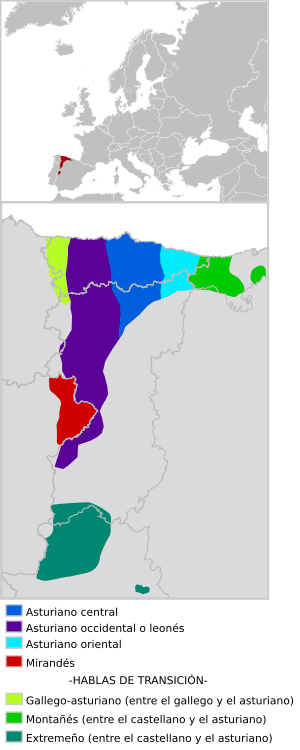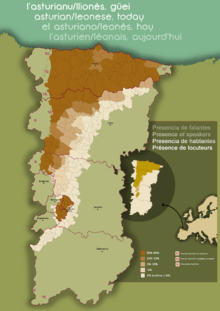Asturleonese language
Asturleonese (Asturian: Asturlleonés, Spanish: Asturleonés) is a Romance language spoken primarily in northwestern Spain, namely in historical regions and Spain's modern-day autonomous communities of Asturias, northwestern Castile and León and Cantabria. The name of the language is largely uncommon among its native speakers, as it forms a dialect continuum of mutually intelligible varieties and therefore it is primarily referred to by various regional glossonyms like Leonese, Cantabrian, Asturian or Mirandese (in Portugal). Extremaduran is sometimes included as well.
| Asturleonese | |
|---|---|
| Asturllionés | |
| Geographic distribution | Spain (Asturias, northwestern Castile and León and Cantabria) and small border areas in northeastern Portugal |
| Linguistic classification | Indo-European
|
| Subdivisions | |
| Glottolog | astu1244 (Asturo-Leonese)[1] extr1243 (Extremaduran)[2] |
 Asturleonese area | |
Phylogenetically, Asturleonese belongs to the West Iberian branch that gradually developed from Vulgar Latin in the Kingdom of León. The Asturleonese group is subdivided into three linguistic variants (Western, Central and Eastern) that form the vertical Asturleonese region, from Asturias, through León, to the north of Portugal and Extremadura. The Cantabrian Montañes in the East and Extremaduran in the South are the variants that contain linguistic signs of transition with the domain of Castilian.
Leonese (used interchangeably with Asturleonese) was once regarded as an informal dialect (basilect) that developed from Castilian Spanish, but in 1906, Ramón Menéndez Pidal showed it developed from Latin independently, coming into its earliest distinguishable form during the Kingdom of León.[3][4][5] As is noted by the Spanish scholar Inés Fernández Ordóñez, Menéndez Pidal always maintained that the Spanish language (or the common Spanish language, la lengua común española, as he sometimes called it) evolved from a Castilian base which would have absorbed, or merged with, Leonese and Aragonese.[6] In his works Historia de la Lengua Española ('History of the Spanish language') and especially El español en sus primeros tiempos ('Spanish in its early times'), Menéndez Pidal explains the stages of this process, taking into account the influence Leonese and Aragonese had on the beginnings of modern Castilian Spanish.
Asturleonese is officially recognised by the Autonomous Community of Castile and León (2006). In Asturias, it is protected under the Autonomous Statute legislation. The language is optional at school, where it is widely studied.[7]
In Portugal, the related Mirandese dialect is recognized by the Assembly of the Republic as a co-official language along with Portuguese for local matters, and it is taught in public schools in the areas where Mirandese is natively spoken. Initially thought to be a basilect of Portuguese, José Leite de Vasconcelos studied Mirandese and concluded it was a separate language from Portuguese.
Usage of glossonyms
Given the low social and political acceptance of referring to the language in Asturias as Leonese, and the one in other parts of the domain (such as León or Zamora) as Asturian (even though it is virtually the same language), a significant part of the authors and specialists prefer to refer to all the dialects collectively as Asturllionés or Asturleonés, although others continue to use the regional terms (like Leonese, Asturian, Mirandese, etc.).
History
The language developed from Vulgar Latin with contributions from the pre-Roman languages which were spoken in the territory of the Astures, an ancient tribe of the Iberian peninsula. Castilian (Spanish) came to the area later in the 14th century when the central administration sent emissaries and functionaries to occupy political and ecclesiastical offices.
Asturian (Asturianu)
Much effort has been made since 1974 to protect and promote Asturian.[8] In 1981 Asturian, or Bable, as the language is officially named,[9] was recognized as an area in need of special protection by the local government. In 1994 there were 100,000 first language speakers and 450,000 second language speakers able to speak or understand Asturian.[10] However, the outlook for Asturian remains critical, with a large decline in the number of speakers in the last 100 years. At the end of the 20th century, the Academia de la Llingua Asturiana underwent initiatives designed to provide the language with most of the tools needed to survive in the modern era: a grammar, a dictionary and periodicals. A new generation of Asturian writers has championed the language. These developments have given Asturian greater hope of survival.

Leonese (Llionés)
Leonese was probably spoken in a much larger area in the Middle Ages, roughly corresponding to the old Kingdom of León. As the Castilian language became the main language in Spain, the linguistic features of the Leonese language retreated progressively westwards. In the late 1990s several associations unofficially promoted Leonese language courses. In 2001 the Universidad de León (University of León) created a course for Leonese teachers, and local and provincial governments developed Leonese language courses for adults. Nowadays Leonese can be studied in the largest towns of León, Zamora and Salamanca provinces.

Leonese's desperate reality as a minority language has driven it to an apparent dead end, and it is considered a Seriously Endangered Language by UNESCO. There are some efforts at language revival aimed at the urban population (the Leonese Council has made campaign to encourage young people to learn Leonese). Some experts think Leonese will be dead in two generations.
In spite of all these difficulties, the number of young people learning and using Leonese (mainly as a written language) has increased substantially in recent years. The Leonese City Council promotes Leonese language courses for adults. Leonese is taught in sixteen schools in Leon.
Leonese language has special status in the Statute of Autonomy of Castile and León.[11]
Mirandese (Mirandês)
In the 19th century, José Leite de Vasconcelos described Mirandese as "the language of the farms, work, home, and love between the Mirandese," noting that it was a fully separate language from Portuguese. Since 1986/87 the language has been taught to students between the ages of 10 and 11, and Mirandese is now recovering. Today Mirandese has fewer than 5,000 speakers (but the figure goes up to 15,000 if one includes second language speakers).
Portugal took a further step in protecting Mirandese when the Portuguese Republic officially recognised the language in 1999.[12] It is administrated by the Anstituto de la Lhéngua Mirandesa.
References
- Hammarström, Harald; Forkel, Robert; Haspelmath, Martin, eds. (2017). "Asturo-Leonese". Glottolog 3.0. Jena, Germany: Max Planck Institute for the Science of Human History.
- Hammarström, Harald; Forkel, Robert; Haspelmath, Martin, eds. (2017). "Extremaduran". Glottolog 3.0. Jena, Germany: Max Planck Institute for the Science of Human History.
- Menéndez Pidal 1906:128–141
- UNESCO Interactive Atlas of the World's Languages in Danger. Archived August 28, 2010, at the Wayback Machine
- Ethnologue report for Spain Archived August 30, 2006, at the Wayback Machine.
- Fernández Ordóñez, "Menéndez Pidal and the beginnings of Ibero-Romance dialectology: a critical survey one century later". In: Ramón Menéndez Pidal after Forty Years: A Reassessment / ed. Juan Carlos Conde, 2010, pp. 113–145, 11–41
- Euromosaic report, Lexikon der romanitischen Linguistik 6.I:652-708
- Bauske 1995
- Statute of Autonomy of Asturias, article 4 (in Spanish)
- Llera Ramo 1994
- Statute of Autonomy of Castile and León, article 5(2) (in Spanish)
- Law 7/99 (in Portuguese)
- (in German) (in Spanish) Bauske, Bernd (1995) Sprachplannung des Asturianischen. Die Normierung und Normalisierung einer romanischen Kleinsprache in Spannungsfeld von Linguistik, Literatur und Politic. Berlin, Köster (There's also a Spanish translation: (1998) Planificación lingüística del asturiano. Xixón, Vtp ISBN 84-89880-20-4)
- (in German) (in Spanish) Lexikon der Romanitischen Linguistik, Bd. 6.I: Aragonesisch/Navarresisch, Spanisch, Asturianisch/Leonesisch. Tübingen, Max Niemeyer, ISBN 3-484-50250-9.
- Llera Ramo, F. (1994). Los Asturianos y la lengua Asturiana: Estudio Sociolingüístico para Asturias - 1991 (in Spanish). Oviedo: Consejería de Educación y Cultura del Principado de Asturias. ISBN 84-7847-297-5..
- (in Spanish) Menéndez Pidal, R (1906): "El dialecto Leonés", Revista de Archivos, Bibliotecas y Museos 2-3:128-172, 4-5:294-311 (There's a modern reprint: (2006) El dialecto Leonés. León, El Buho Viajero ISBN 84-933781-6-X)
- Wurm, Stephen A., ed. (2001). Atlas of the World's Languages in Danger of Disappearing. UNESCO. ISBN 92-3-103798-6.
External links
- Héctor García Gil. Asturian-leonese: Linguistic, Sociolinguistic and Legal Aspects.
- Academia de la Llingua Asturiana – Academy of the Asturian Language – Official website
- Asturian grammar in English
- Xunta pola Defensa de la Llingua Asturiana – Committee for the Defense of Asturian Language
- Oficina de Política Llingüística del Gobiernu del Principáu d'Asturies – Bureau of Asturian Linguistic Politics (Government of the Principality of Asturias)
- Real Instituto de Estudios Asturianos – Royal Institute of Asturian Studies (RIDEA or IDEA), founded 1945.
- Asturian–English dictionary
- Entry on José Leite de Vasconcelos at the Folclore Português website
- - González i Planas, Francesc. Institutum Studiorum Romanicorum «Romania Minor». The Asturleonese Dialects.
- La Caleya - Cultural Association.
- Furmientu Cultural Association.
- Faceira Cultural Association.
- El Teixu Cultural Association.
- González Riaño, Xosé Antón; García Arias, Xosé Lluis: "II Estudiu Sociollingüísticu De Lleón: Identidá, conciencia d'usu y actitúes llingüístiques de la población lleonesa". Academia de la Llingua Asturiana, 2008. ISBN 978-84-8168-448-3.
- Pardo, Abel. "El Llïonés y las TICs". Mikroglottika Yearbook 2008. Págs 109-122. Peter Lang. Frankfurt am Main. 2008.
- Staaff, Erik. : "Étude sur l'ancien dialecte léonais d'après les chartes du XIIIe siècle", Uppsala. 1907.